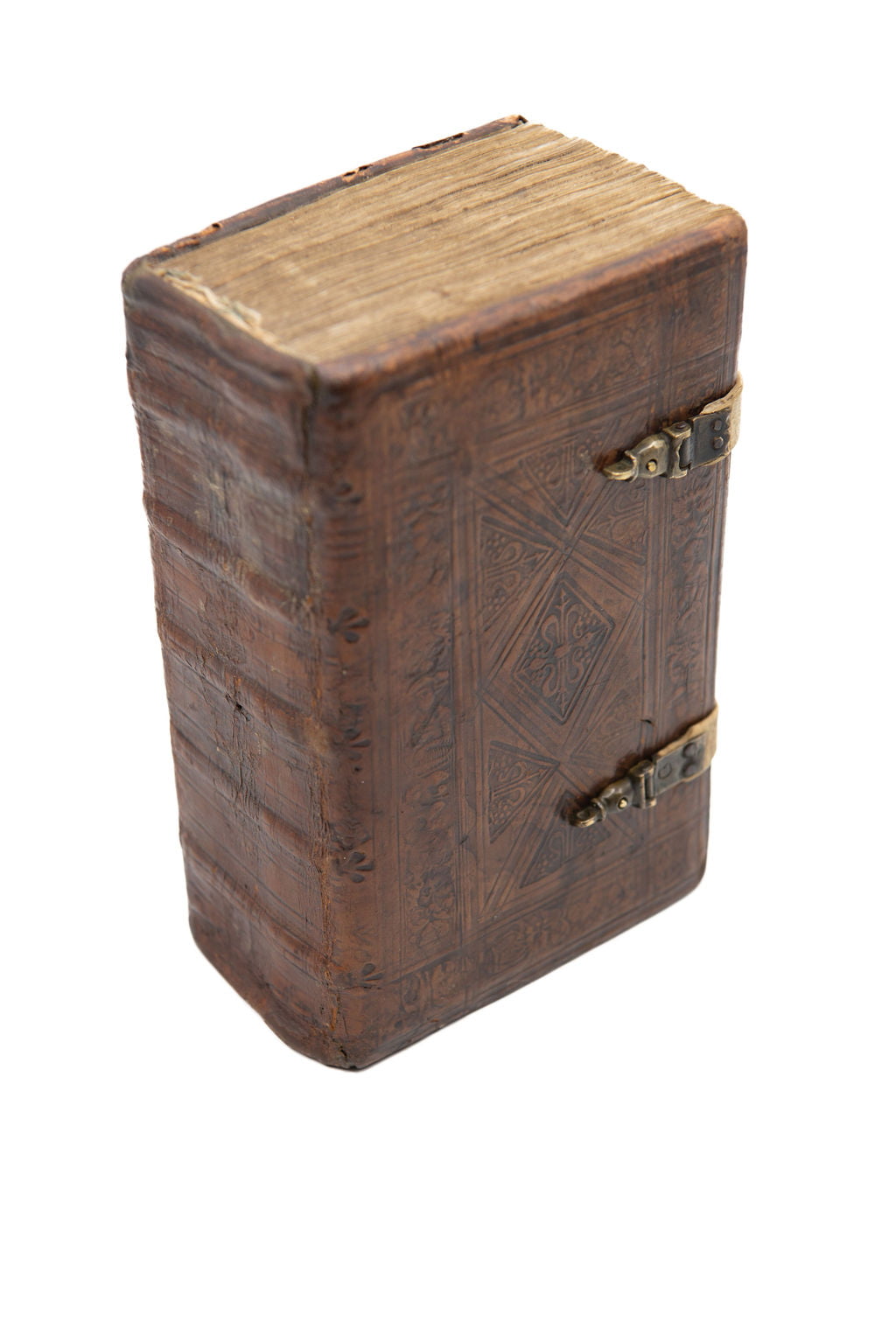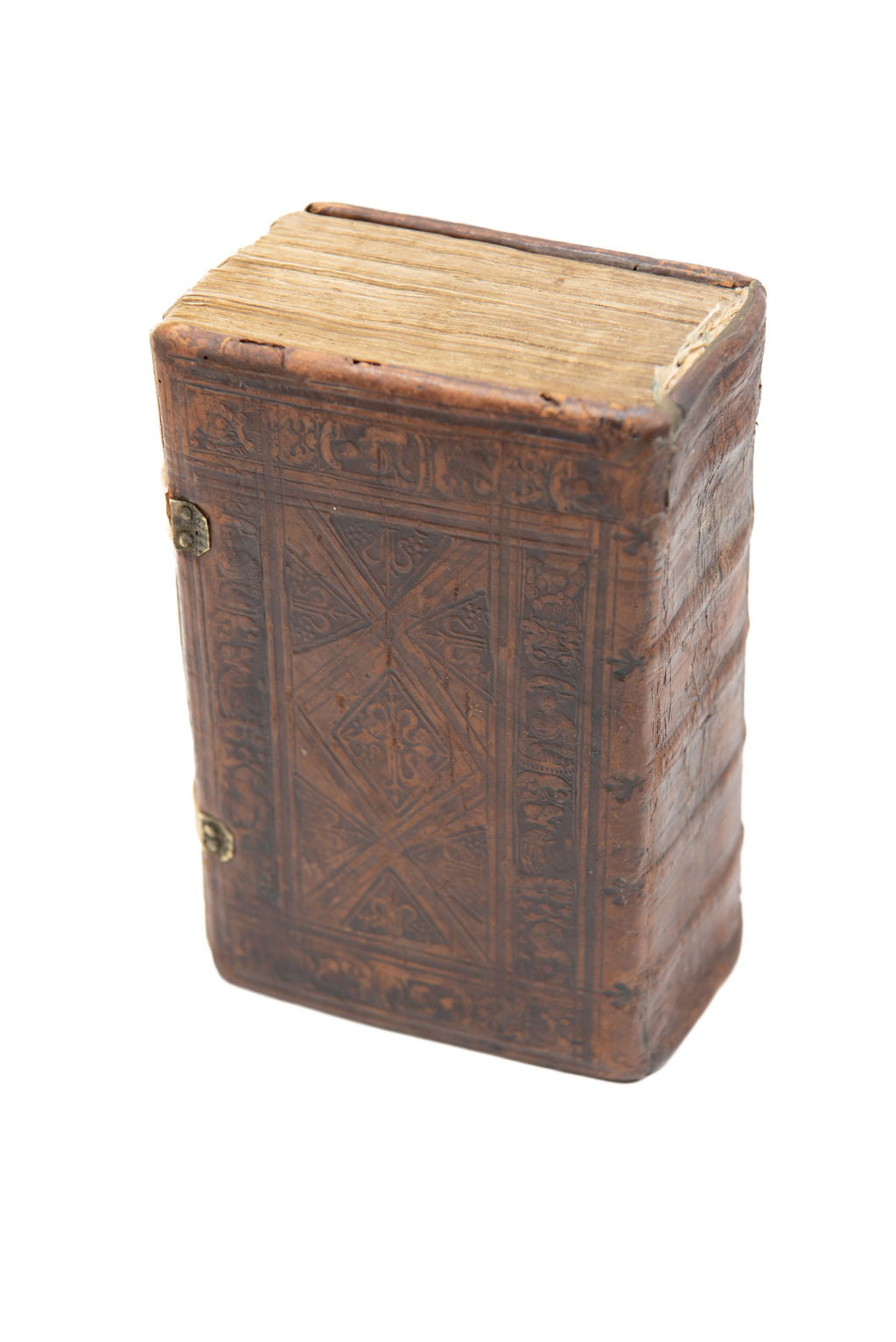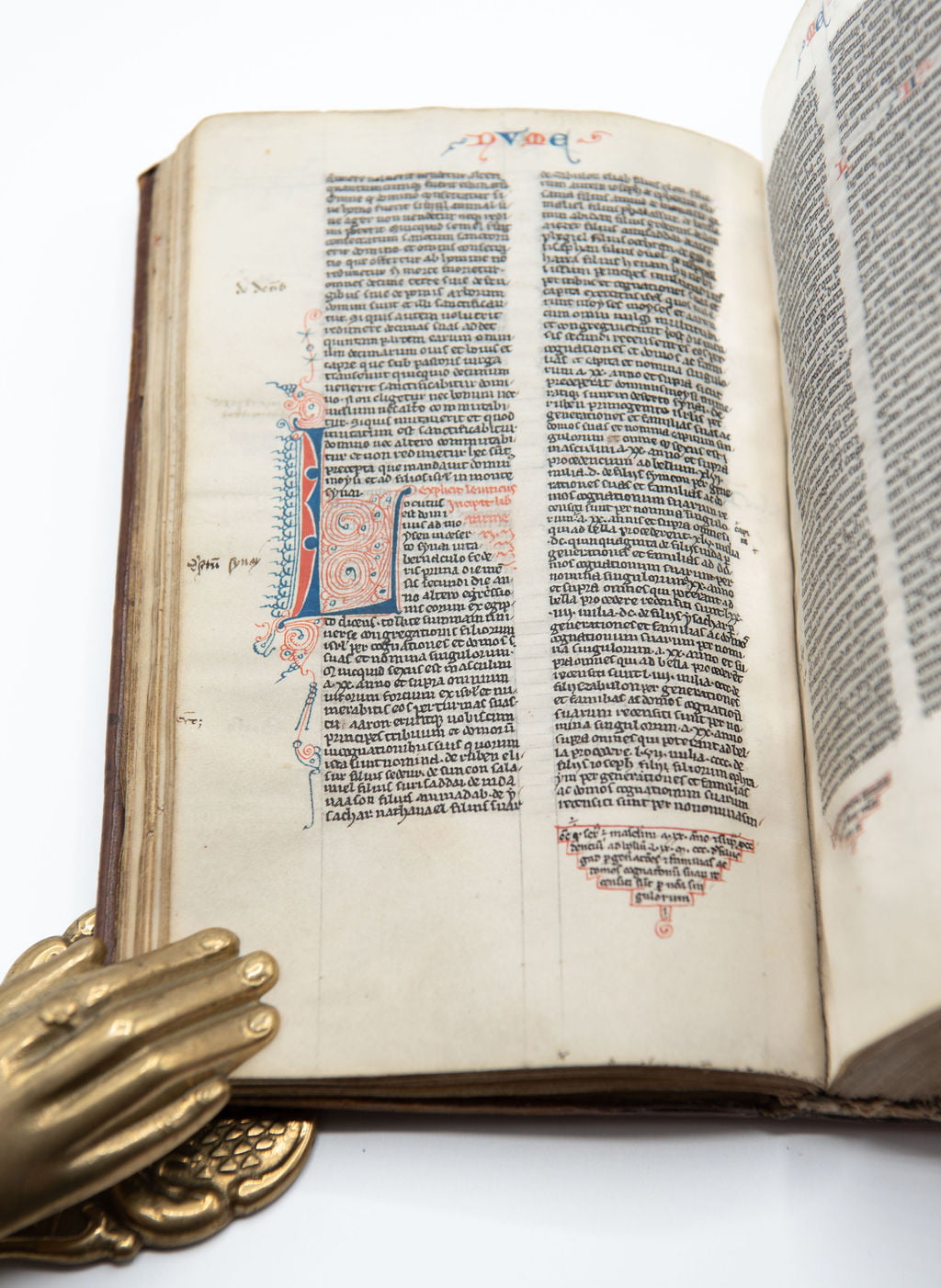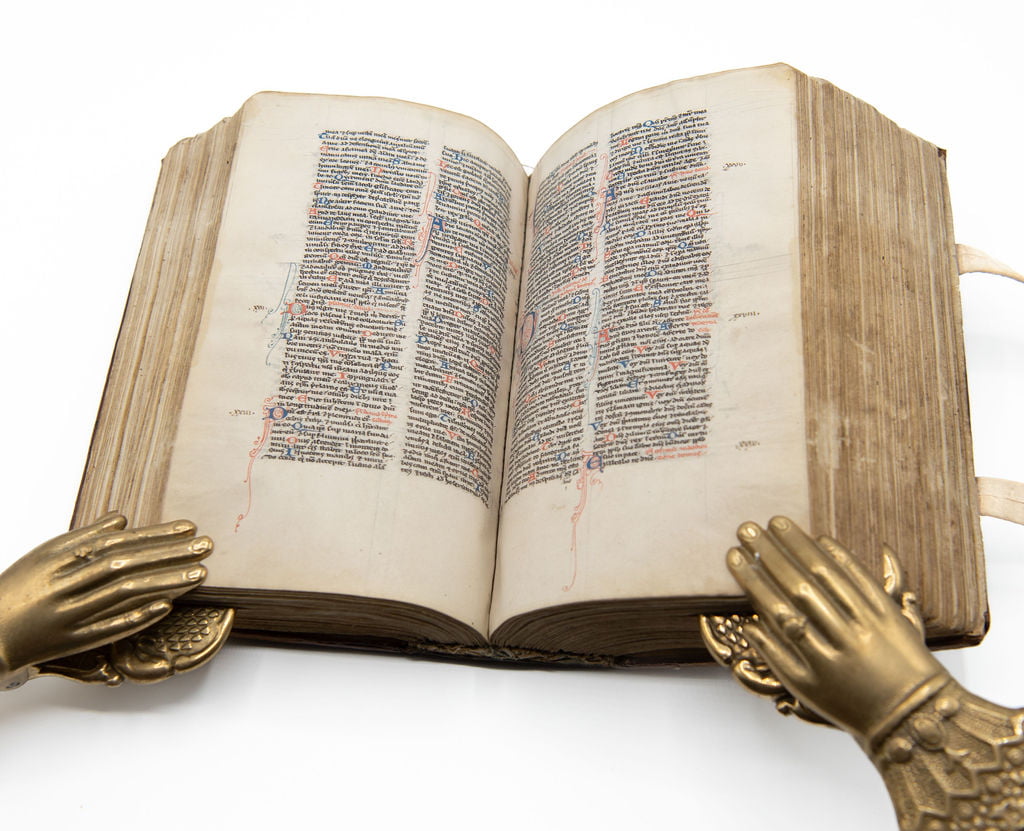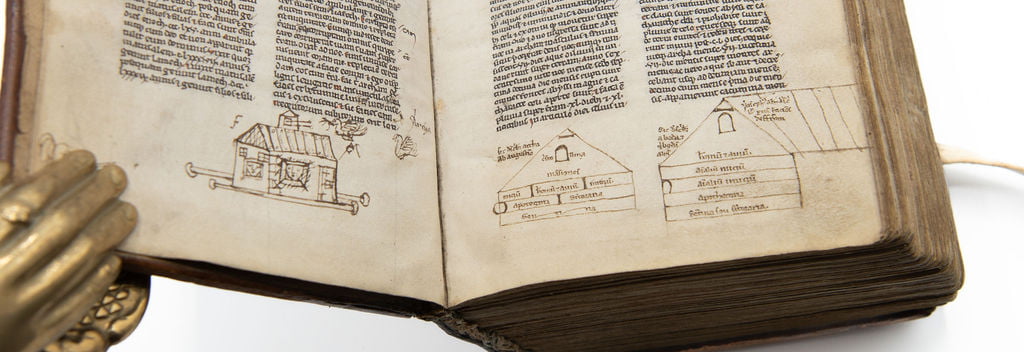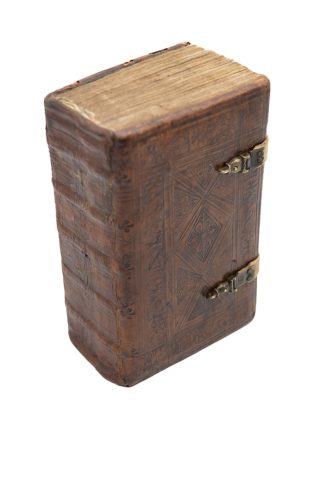BIBLE, decorated manuscript
MEDIEVAL ENGLISH INTEREST IN JUDAISM
Bible, in Latin, decorated manuscript on vellum
England, perhaps Oxford, mid 13th century (probably c. 1260)£175,000.00
Large 8vo, 192 x 130mm. x 80mm. thick. 549 leaves (plus endleaf at front, and including endleaf at back), collation impossible but textually complete. Rubricator made numerous mistakes corrected by contemporaries or near-contemporaries, and despite an apparent jump in II Esdra from chapter III to VII there is no text loss. Double column, 53-54 lines in an excellent professional early gothic bookhand, capitals touched in red, rubricated, small initials in alternate red and blue, chapter numbers and running titles in same, one-hundred-and-seventeen larger initials in variegated red and blue panels with elaborate scrolling penwork with scallop-shapes and patterns of circles and trailing stems in same colours, enclosing swirling foliage, numerous near-contemporary and early marginal additions (some set within geometric shapes in margin picked out with red outlines, and a few pointing hands as well as so-called ‘clover marks’. Single hand pointing to a flying bird, most probably the Holy Spirit), two leaves with near-contemporary marginal drawings of God’s hand emerging from a cloud and directing Noah and another looking out of the Ark as the dove returned with a sprig of foliage, as well as two diagrams of the levels of the ark with their types of inhabitant drawn “ab augustino”. One front endleaf cut away, foot of first text leaf cut away probably to remove ownership inscription, splits to corners of a small number of leaves, slight cockling in places, small spots and stains. In excellent, most presentable condition, later medieval binding of dark brown leather over wooden boards, tooled with fleur-de-lys within chevrons and roll-stamps, sewn on thick thongs, two clasps of leather ties with metal endpieces which attach to metal pegs set in front board, scuffing to boards in places and slight tears at corners of spine, overall good and robust. In folding box.
This is a handsome and weighty thirteenth-century most probably English Bible, the format in which most readers of the Middle Ages knew the complete text. Due to its vast size, most Early Medieval Biblical books included only sections of the complete canon, but the needs of students in the fledging university in Paris in the late twelfth and thirteenth centuries lead to advancements in the methods of book production in order to mass-produce complete copies for that market. Script became miniaturised and the words themselves heavily abbreviated in an effort to push resources to their limit, and at the same time libraires or master-book producers divided up master-copies to hand out in sections (or pecia) to multiple copyists at once, dramatically increasing the rate of copying. Thus they survived relatively in large numbers. However their multiple decorated initials and fine script often attracted the attentions of the commercial book dispersers from the nineteenth century onwards, and they have become fewer and fewer in the market in the last century, with examples continuing to fetch record prices.
Here the form of the text is mostly that of a more common Parisian Bible, and with the standard abbreviations of Hebrew names in the form “Aaz apprehendens …” at its end. Crucially, however, the script and penwork decoration here appear English and the books of Tobit, Judith and Esther are in the order usually identifying English use. In addition, the early notes on Hebrew at the end of the book strongly indicate an early use in a medieval English scholarly setting (see below).
What is perhaps most notable about this book is the interest of an early user in the Hebrew Bible. Additions to endleaves at the front of the volume suggest a contemporary or near-contemporary use in theological teaching or preaching, perhaps in a cathedral school (see below), but a page of notes added in the decades after the book’s production to blank space before the abbreviations of Hebrew names indicates a more specific use. This begins with the words “Thorath id est lex” with five penlines drawn off to associated lines of text. These text-lines reveal that the scribe was attempting to describe the contents of the Torah – the Hebrew Bible, here described accurately as ‘the law [of Moses]’, and each line opens with a somewhat garbled version of the opening words of the first five books of the Old Testament:
“Bresith” – in fact Bereshit (Genesis, ie. ‘In the beginning’)
“Ellesmoth” – in fact Shemot (Exodus, ie. ‘Names’)
“Vaietra” – in fact Vayikra (Leviticus, ie. ‘And he called’)
“Vagedabar” – in fact Bamidbar (Numbers, ie. ‘In the desert’)
“Addabarim” – in fact Devarim (Deuteronomy, ie. ‘The words’)
These are followed by a section of brief notes on Old Testament prophets and other figures from the Hebrew section of the Bible, as well as an observation on the absence of Baruch “In hebreo canone” (‘in the Hebrew canon’). This section terminates with more usual notes on religious ideals and relative Biblical dates.
Despite Jerome’s and Bede’s insistence on the primacy of Hebrew as a Biblical language for Old Testament texts such as the Psalms (and indeed in some medieval accounts, the original language of all mankind), actual records of northern European interest in the language or its religious texts before the Renaissance are few[1], and astoundingly so from England which had no Jewish population before 1066 and none after Edward I expelled what Hebrew speakers it had in 1290. Indeed a memory of interacting with Jews in religious discussions as a youth and then their subsequent exile some years before the period in which these additions most probably were made might well explain these strange and fascinating additions by the present scribe, as well as their garbling from his slightly faulty memory. As such this volume would appear to bear witness to the impact of the English Jewry on theological thinking and teaching in medieval England, even after the expulsion of 1290.
[1] We might cite here the allusions by the grand scholars William of Auvergne (bishop of Paris, d. 1249) and Alexander of Hales (taught University of Paris, d. 1245) to fleeting knowledge of the works of Maimonides either through translations from Hebrew or oral contact (on these see G.K. Hasselhoff, ‘Maimonides in the Latin Middle Ages: An Introductory Survey’, Jewish Studies Quarterly 9 (2002), pp. 1-20). However, note that while Alexander of Hales was English by birth, he worked in Paris, and this interest is more probably a continental university phenomenon, and certainly so after 1290. Provenance:1. Most probably written and decorated in England in the mid-thirteenth century. Certainly the book was there in the decades after its production: notes on the Hebrew Old Testament added in the century after the book was written before the abbreviations of Hebrew names give a garbled version of the name ‘Joshua ben Num’ (here misunderstood and reversed as “Benstryn i[d est] Josue”) spell this erroneous name ‘Benstryn’ with a ‘y’ used as a semi-vowel in place of the more usual ‘i’, a practice distinctive to English, and common in Middle English. Other additions to the endleaves suggest a use of the volume in both theological study and preaching at various times of the year, and more specific references to the services for the consecration of deacons and other episcopal and clerical functions might just identify the medieval library in which this book survived as that of a cathedral school.2. The modern re-emergence of the book on the Continent might suggest that it was carried into exile there by an ecclesiastic during the English Reformation (for another such Bible carried away from the cathedral school of Canterbury in the same period, see the ‘Trussel/Lyghfield Bible’ once Schøyen collection and sold in Bloomsbury Auctions, 10 July 2018, lot 81, now Canterbury Archives). If so, it must have passed to a religious community in northern France or the Low Countries until the French Revolution and Secularisation in the last years of the eighteenth century.In stock


